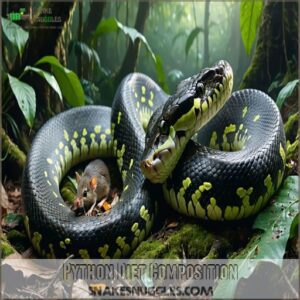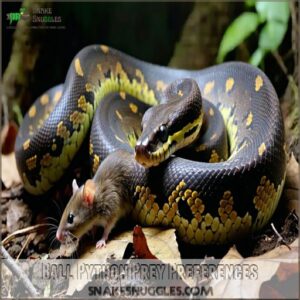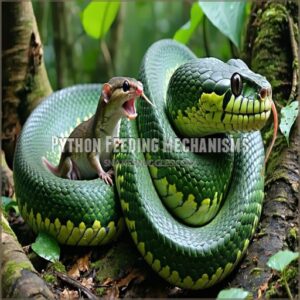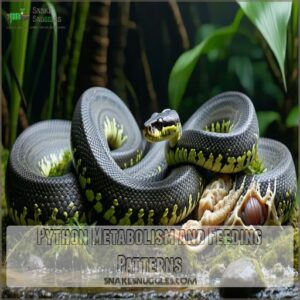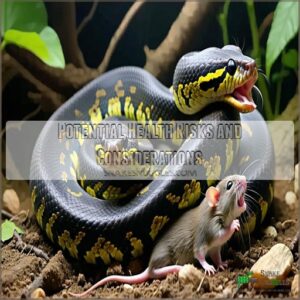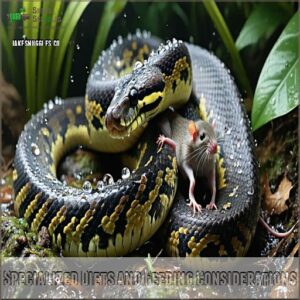This site is supported by our readers. We may earn a commission, at no cost to you, if you purchase through links.
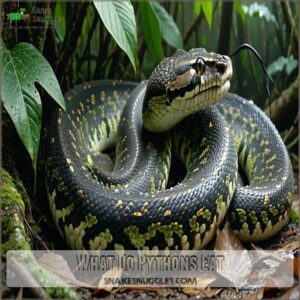 If you’re curious about what pythons eat, you’ll find they’re not picky eaters! These skilled hunters use heat-sensing pits to locate warm-blooded prey like rats, pigs, and deer.
If you’re curious about what pythons eat, you’ll find they’re not picky eaters! These skilled hunters use heat-sensing pits to locate warm-blooded prey like rats, pigs, and deer.
Larger pythons can even take down alligators. You’ll also find birds, lizards, and even other snakes on their menu. They use ambush tactics and constriction to secure their meals.
So, what do pythons eat? In short, anything they can get their jaws around! There’s much more to uncover about these fascinating predators.
Table Of Contents
- Key Takeaways
- What Do Pythons Eat
- Python Diet Composition
- Types of Pythons and Their Diets
- Python Feeding Mechanisms
- Python Metabolism and Feeding Patterns
- Captive Python Nutrition and Feeding
- Python Feeding Behavior and Adaptations
- Potential Health Risks and Considerations
- Specialized Diets and Feeding Considerations
- Frequently Asked Questions (FAQs)
- What do python snakes eat?
- What do pythons eat as pets?
- What do ball pythons eat?
- How big should a Python eat?
- Should pythons eat live or pre-killed food?
- What do Burmese pythons eat?
- What do you feed a python?
- Can a python swallow a deer?
- What’s the biggest thing a python can eat?
- Do pythons eat live animals?
- Conclusion
Key Takeaways
- You’ll find that pythons eat a variety of prey, from small rodents and birds to larger animals like deer and even crocodiles, depending on their size and species.
- They’re ambush predators, using heat-sensing pits, constriction, and flexible jaws to capture and swallow prey much larger than themselves.
- In captivity, it’s best to feed pythons appropriately sized pre-killed prey, like mice or rats, to ensure safety and mimic their natural feeding habits.
- Pythons can go months without eating due to their slow metabolism, but when they feed, their energy expenditure and digestion rates skyrocket.
What Do Pythons Eat

You’ll find that pythons don’t follow a one-size-fits-all menu, as these remarkable snakes consume everything from small rodents to larger prey like deer, depending on their species and size.
While smaller pythons might make a meal of mice and birds, larger species can tackle impressive prey that’s even bigger than their own heads, thanks to their incredibly flexible jaws and ability to consume small rodents and larger prey.
Natural Prey and Feeding Habits
Regarding python feeding habits in the wild, these skilled predators have evolved remarkable hunting tactics that maximize their chances of success.
You’ll find their prey selection varies based on habitat and size, with feeding cycles typically occurring every few weeks.
Here’s what makes their wild foraging truly fascinating:
- They’ll strike with lightning speed, using their muscular bodies to constrict prey
- They can detect warm-blooded animals using heat-sensing pits
- They’ll patiently wait in ambush, sometimes for days, to catch the perfect meal
Common Prey Animals in The Wild
Python prey animals range from tiny mice to impressive deer, showing these snakes’ remarkable appetite for wildlife prey.
You’ll find these forest creatures hunting everything from small mammals to bird species across their habitats.
Here’s a breakdown of their common food sources:
| Python Food Type | Common Examples |
|---|---|
| Mammals | Rats, Deer, Pigs |
| Birds | Various Species |
| Reptiles | Lizards, Snakes |
| Amphibians | Frogs |
| Fish | Alligators |
Hunting Techniques and Strategies
Like skilled ninjas, these remarkable reptiles master the art of ambush tactics and stealth methods. Their backward-facing teeth and muscular bodies work together in a deadly dance of constriction techniques.
You’ll find their hunting styles particularly fascinating, as they employ sophisticated prey detection systems:
- Heat-sensing pits detect warm-blooded animals with pinpoint accuracy
- Backward-facing teeth grip prey securely during the strike
- Specialized bite-and-grasp techniques guarantee successful constriction
Frequency of Feeding in Nature
In the wild, python feeding habits follow remarkable cycles of feast and fast.
These incredible snakes can survive up to 18 months without eating, though younger ones need more frequent meals.
While captive pythons typically eat weekly, their wild counterparts adjust their feeding intervals based on prey availability and metabolism.
You’ll find most adult pythons in nature consuming substantial meals every few weeks to months, demonstrating impressive natural hunger control.
Python Diet Composition
You’ll find that pythons are skilled hunters with a taste for everything from small rodents to medium-sized deer, depending on their species and size.
These impressive constrictors can consume prey up to five times the width of their head, thanks to their incredibly flexible jaws and elastic skin.
Carnivorous Diet and Prey Selection
Understanding python feeding habits reveals their remarkable carnivore adaptations. You’ll find these skilled predators using advanced predator tactics to target specific prey, from small rodents to larger mammals.
Their wild foraging patterns showcase impressive python eating behavior, as they’ve evolved specialized mechanisms for prey capture. Whether ambushing or actively hunting, pythons demonstrate selective python food preferences based on their size, habitat, and energy needs.
For proper nutrition, it’s necessary to research a suitable snake diet to guarantee the well-being of these carnivorous creatures.
Seasonal Variations in Python Diets
Python’s seasonal habits shift dramatically with their environment.
During wet seasons, they’ll target amphibians and small crocodiles, while dry periods push them to energy-rich mammals like pigs and deer.
Temperature changes affect their feeding cycles too – they’ll hunt more actively when prey’s abundant in warm months, but conserve energy during scarce times.
These dietary shifts help them survive in diverse ecosystems year-round.
Prey Size and Python Species
Just as weather patterns shape python diets, their size directly influences prey selection.
You’ll notice each species has evolved specific hunting tactics to match their food chain position. A ball python might stick to mice, while a massive reticulated python tackles larger game.
- A 3-foot ball python swallowing a plump adult rat
- A 15-foot Burmese python wrapping around a wild boar
- An African rock python stretching its jaws around a gazelle
- A young carpet python catching tree frogs
- A reticulated python swimming after waterfowl
Types of Pythons and Their Diets
You’ll find that different python species have unique appetites, from the Ball python‘s preference for small rodents to the massive Reticulated python‘s ability to take down deer.
Whether you’re studying these fascinating creatures or simply curious about their eating habits, you’ll discover that each python species has evolved specialized hunting techniques and dietary preferences that help them thrive in their natural habitats.
Ball Python Prey Preferences
In the wild, ball pythons showcase selective hunting tactics, targeting lean prey like small birds and multimammate rats. You’ll find their food preferences differ between natural and captive environments.
Understanding Ball Python care is essential for replicating their natural diet in captivity. Here’s a breakdown of their typical diet patterns:
| Age Group | Wild Food Sources | Captive Diet |
|---|---|---|
| Juveniles | Small Birds | Young Rats |
| Adults | Multimammates | Adult Rats |
| Breeding | Lean Prey | Specialized Rodents |
| Senior | Easy-catch Prey | Pre-killed Rats |
Their natural python diet emphasizes leaner prey options compared to captive feeding, which is an important aspect of captive environments and selective hunting tactics, including targeting small birds.
Burmese Python’s Large Prey Capacity
While smaller pythons stick to rodents, Burmese pythons take prey size limits to another level.
These impressive hunters can swallow animals larger than their own heads, thanks to highly elastic skin and flexible jaws.
You’ll find them tackling wild prey selection from goats to deer, and even small cattle, utilizing their constriction methods and powerful digestive enzymes to break down bones and fur completely.
African Rock Python Feeding Behavior
When hunting, African rock pythons showcase remarkable prey capture abilities, with tactics that’ll leave you amazed.
These powerful constrictors target everything from rodents to warthogs, adapting their feeding habits to whatever’s available.
You’ll find them most active at night, using heat-sensing pits to track warm-blooded meals.
Their wild diet even includes surprising catches like crocodiles and monitor lizards, proving they’re nature’s ultimate opportunistic hunters.
Reticulated Python’s Hunting Techniques
The reticulated python’s stealth attacks rely heavily on scent trails to track potential meals.
These masters of prey ambush use their incredible snake camouflage to blend into forests and grasslands, often waiting motionless for days.
Their hunting strategies prove remarkably effective, with research showing they’re responsible for up to 77% of prey captures in their habitat, making them dominant predators in the python food chain.
Efforts like the python program aim to mitigate the impact of invasive pythons on native wildlife.
Python Feeding Mechanisms
You’ll be amazed at how pythons can swallow prey much larger than their heads, thanks to their incredibly flexible jaws and specialized teeth that point backward.
When you watch a python eat, you’re witnessing one of nature’s most efficient feeding systems at work, complete with powerful muscles that squeeze prey and digestive enzymes that can break down bones and fur.
Unique Jaw Structure for Swallowing
You’ve probably wondered how pythons manage to swallow prey larger than their heads.
Their jaw structure is a marvel of evolution, featuring highly flexible joints and ligaments that allow independent movement of each side.
Here’s what makes their swallowing techniques so effective:
- Quadrate bones disconnect to expand jaw width dramatically
- Elastic ligaments stretch up to three times their normal size
- Multiple rows of curved teeth guide prey inward smoothly
- Specialized skin folds accommodate extreme stretching to facilitate independent movement
Constriction Process and Prey Suffocation
Contrary to popular belief, python constriction doesn’t crush bones or squeeze lungs – it’s all about blood flow.
During prey capture, pythons use sophisticated hunting tactics to ambush and coil around their target.
Their constriction methods progressively tighten with each exhale, leading to rapid circulatory failure.
| Constriction Phase | Duration | Effect |
|---|---|---|
| Initial Strike | 1-2 seconds | Quick prey capture |
| Coiling | 5-10 seconds | Blood flow restriction |
| Final Tightening | 2-5 minutes | Complete circulatory shutdown |
Digestive Enzymes and Stomach Acid Strength
While a python swallows its prey whole, its stomach immediately kicks into high gear with intense enzyme production and gastric acid secretion. The stomach pH rapidly drops from 7.5 to an incredibly acidic 2.0.
Here’s what makes python digestion a powerhouse:
The unique process of snake digestion allows for efficient breakdown of prey.
- Stomach acid reaches a pH of 1.5 – strong enough to dissolve bones
- Digestive enzymes activate instantly after feeding
- Gut health depends on specialized acid production
- Their metabolic rate spikes for efficient digestion
Duration of Digestion Process
Those powerful stomach acids you’ve read about kickstart a fascinating process.
Your python’s digestion time varies based on prey size and metabolic speed – it can take anywhere from 4 to 14 days for complete food breakdown.
Gut movement and absorption rates slow down as the meal progresses, letting pythons extract maximum nutrients.
You’ll notice your python becoming less active during this time, conserving energy for efficient digestion.
Python Metabolism and Feeding Patterns
You’ll be amazed to learn that pythons can survive for months between meals thanks to their remarkably slow metabolism and energy-efficient bodies.
When they do eat, their metabolic rate dramatically increases as their bodies work overtime to break down large prey, much like your car engine revving up to climb a steep hill.
Energy Conservation Between Meals
Recent research shows pythons are incredible energy-savers between meals. After digesting their food, these remarkable snakes enter an extended metabolic slowdown that puts any power-saving mode to shame.
- Their gastric metabolism drops by 50% during fasting periods
- Body temperature regulation fine-tunes energy conservation
- They oxidize only 0.24% of meal lipids in two weeks
- Liver adapts to handle nutrient overload efficiently
- Energy reserves maintain body condition during fasting
Python feeding patterns showcase nature’s ultimate survival strategy, with their dietary efficiency allowing extended periods without food, making them a great example of energy conservation and metabolic slowdown that helps in energy-savers.
Metabolic Rate Changes During Digestion
While pythons conserve energy during fasting, their metabolic rate skyrockets during digestion.
You’ll be amazed to learn that a python’s energy expenditure can jump up to 1600% after a meal – that’s higher than during exercise.
This metabolic shift triggers increased heart rates and organ growth, particularly in the small intestine and liver.
Temperature plays a key role too, affecting digestion speed and nutrient absorption efficiency.
Fasting Periods in Wild and Captive Pythons
Studies show that pythons can go through remarkable fasting periods lasting up to 4.2 months in the wild. You’ll find these incredible serpents manage their python food sources differently based on their environment.
Here’s what you need to know about python eating habits:
- Wild pythons lose only 0.004% body mass per day during fasting
- Captive pythons may fast due to stress or seasonal changes
- Feeding frequency varies between wild and captive settings
- Python nutritional needs remain stable during fasting
- Pythons quickly resume growth once feeding restarts
Impact of Temperature on Feeding Frequency
Mastering thermal regulation directly impacts python feeding frequency, with warmer temperatures speeding up digestion and allowing more frequent meals.
Temperature fluctuations trigger specific metabolic responses in pythons, affecting how quickly they process python food sources.
You’ll notice that climate effects play a significant role in their feeding cycles – at higher temperatures, pythons demonstrate enhanced eating patterns, though their strike performance only slightly improves.
Captive Python Nutrition and Feeding
You’ll find that feeding your pet python isn’t as mysterious as it might seem, though it does require careful attention to prey size, nutritional balance, and feeding schedules.
Whether you’re considering pre-killed rodents or exploring supplement options, understanding your python’s dietary needs will help you maintain its health and prevent common feeding-related issues.
Recommended Prey Items for Pet Pythons
Your pet python’s nutrition starts with proper prey selection. For complete python nutrition, offer whole prey that includes fur, bones, organs, and muscle meat.
Ball pythons thrive on a captive diet of rats and mice, though you can introduce different food types to add variety. When choosing python food types, remember to match the prey size to 10-15% of your snake’s body weight.
Understanding the best python food is important for a balanced diet and overall python nutrition.
Frozen Vs. Live Prey Debate
Regarding python food types, the frozen vs. live prey debate centers on safety and feeding ethics.
While live prey mimics natural hunting instincts, it can injure your snake during the struggle.
Pre-frozen rodents eliminate this risk and guarantee food safety through proper handling, maintaining ideal snake nutrition without compromising your python’s hunting satisfaction.
Most experienced keepers opt for frozen-thawed prey, as it maintains ideal snake nutrition without compromising your python’s hunting satisfaction.
Feeding Schedule for Different Python Ages
Growth stages dictate a python’s feeding cycles, with each age requiring specific dietary needs.
Hatchlings need frequent meals every 5-7 days to fuel rapid growth, while juveniles progress to eating every 10-14 days.
Adult pythons, with their slower metabolisms, thrive on larger meals every 15-30 days, this feeding schedule matches their natural nutrient requirements and guarantees healthy development.
Nutritional Supplements for Captive Pythons
Just like humans need vitamins, captive pythons sometimes benefit from nutritional boosts. While they’ll get most nutrients from whole prey, here’s what you need to know about supplements.
- Calcium powder helps breeding females form healthy eggs
- Multivitamins support bone development in growing pythons
- Most snakes don’t need supplements with a balanced diet
- Too many supplements can harm your python’s health
Using a python calcium supplement can be beneficial in specific situations. Always check with your vet before adding any supplements to your python’s food.
Python Feeding Behavior and Adaptations
You’ll be amazed at how pythons use their muscular bodies and heat-sensing pits to detect and capture prey with impressive accuracy.
Regarding feeding, these remarkable snakes have evolved specialized adaptations that let them swallow animals much larger than their own heads, thanks to their highly flexible jaws and stretchy skin.
Live Prey Vs. Pre-killed Prey
Two key approaches define python feeding habits: live feeding and pre-killed prey selection.
While live prey mirrors natural python hunting behaviors, pre-killed options offer practical benefits for snake nutrition.
Your python’s prey handling preferences matter – most captive snakes can adapt to pre-killed prey over time.
Consider your snake’s individual preferences and feeding response when choosing between these options.
Ethical Considerations of Live Feeding
While pythons naturally hunt live prey in the wild, animal welfare concerns have sparked debates about feeding ethics in captivity.
Modern python food guides emphasize the moral implications of live feeding, considering both snake rights and prey animal welfare.
Research shows that pythons don’t actually need live prey for nutrition or psychological wellness, challenging traditional beliefs about what pythons eat, related to animal welfare concerns.
Safety Concerns for Pythons and Prey
During feeding time, large constrictors pose significant safety risks for both snake and prey. You’ll need to monitor these important safety measures:
- Never leave live prey unattended with your python
- Watch for defensive strikes, which can happen within seconds
- Keep children away during feeding to prevent unexpected reactions
- Remember that even non-aggressive pythons become enthusiastic during meals
Birds of prey, large mammals, and other snakes pose natural threats to pythons in the wild.
Simulating Natural Hunting in Captivity
Puzzle feeders and strategic prey placement form the cornerstone of effective captive hunting techniques for your python.
Create a naturalistic enclosure with deep substrate, climbing branches, and hiding spots to encourage investigation and foraging behaviors.
By incorporating environmental enrichment like scattered prey scents and varied artificial prey presentation methods, you’ll help maintain your python’s natural hunting instincts while supporting their mental and physical well-being.
Understanding the benefits of live prey feeding can also play a significant role in developing a well-rounded approach to python care and nutrition.
Potential Health Risks and Considerations
You’ll need to watch your python’s weight just as carefully as you watch your own, since these remarkable reptiles can face serious health issues from improper feeding.
While pythons in the wild naturally maintain healthy weights through hunting and long periods between meals, your pet python depends on you to establish proper portion sizes and feeding schedules that mirror their natural patterns.
Signs of an Overweight Python
Looking more like a bloated soda can than a sleek predator? Your python might be carrying extra weight.
Keep an eye out for a rounded back where the spine’s barely visible, and check if there’s less definition between the head and neck.
A healthy python’s body condition shows some bulk without excessive roundness, so regular visual assessments help maintain ideal snake health and a healthy python.
Health Risks Associated With Obesity
Like humans, overweight pythons face serious health complications. Your python’s obesity can lead to fatty liver disease, heart problems, and issues with the gallbladder and pancreas.
Beyond the physical toll, excess weight affects their sexual function and mental well-being. Think of it like carrying a heavy backpack all day – it’s exhausting!
Regular exercise and proper snake nutrition are your best tools for preventing these metabolic issues.
Proper Portion Sizes for Different Species
The golden rule of python portion control follows a simple yet important feeding ratio – prey should measure between 1.0 to 1.5 times the thickest part of your python’s body. For precise prey weight calculations, aim for 10-15% of your python’s total body weight. A 600-gram python, for instance, thrives on weekly meals of about 70 grams.
Understanding the snake diet basics is essential for maintaining a healthy and balanced feeding schedule.
- Overfeeding your python isn’t just costly – it’s like forcing a friend to wear pants two sizes too small
- Think of proper portion sizes as your python’s personal meal prep service
- Getting the feeding ratios right helps your python maintain that sleek, healthy silhouette
Exercise and Environment for Healthy Pythons
Proper python enclosures need both exercise opportunities and environmental enrichment to keep your snake healthy.
You’ll want to maintain thermal gradients between 24-28°C and humidity levels of 65-90%.
Install climbing structures to encourage natural movement, and create multiple hiding spots at different temperature zones.
Your python’s enclosure should include deep substrate layers and varied terrain to simulate their wild habitat and promote active behaviors.
To create an ideal environment, consider python accessories that enhance the overall quality of the enclosure.
Specialized Diets and Feeding Considerations
You’ll discover how a python’s diet changes during breeding, illness, or old age. These specialized needs are essential for their well-being, so let’s explore how to provide the best care.
Feeding Regimens for Breeding Pythons
Maintaining a healthy weight is key, especially for breeding pythons. Breeding nutrition requires a keen eye on Python feeding and snake diets. Consider these reptile care guidelines for hatchling food and beyond:
1.Hatchlings eat every 5-7 days.
- Juveniles eat every 7-10 days.
- Adults can stretch to 10-14 days.
Males, focused on mating, can eat less often. Females, however, need more python food list items, especially pre-laying, ensuring a suitable diet pythons thrive on.
What do pythons eat during breeding? It all depends on their stage of life, with what should you feed pythons varying accordingly. Understanding the pythonidae diet is essential for healthy offspring.
Dietary Adjustments for Sick or Injured Snakes
After ensuring your breeding pythons are well-nourished, consider specialized care for sick or injured snakes.
A suitable diet for sick snake care involves weak prey options like smaller rodents.
For injury recovery, offer nutrient supplements and consider medical feeding tubes if needed.
This specific approach supports a python food list adapted to recovery, ensuring appropriate python food size.
Rehydration Techniques for Pythons
Beyond a sick python’s diet, what eats pythons, and python food size, hydration matters. A dehydrated python may have wrinkled skin.
So, how much water do pythons eat? They don’t "eat" water. Provide a large water dish for soaking.
For severe dehydration, consider a shallow, warm bath, always monitoring your python’s well-being. What does python snakes eat won’t fix this. Consult a vet for python food chart details if concerned.
Feeding Considerations for Aging Pythons
Proper senior snake care guarantees your aging python thrives. With age, prioritize aging python nutrition and adjust your python feeding tips.
- Offer smaller, softer prey for easier digestion.
- Reduce feeding frequency to match their slower metabolism.
- Provide access to fresh water for mature python health.
Remember, even elderly snakes need suitable diets and python feeding charts to address their unique needs. This helps maintain a healthy weight and prevents obesity-related risks. Understanding what eats pythons and their natural python predators can offer clues about their preferred food sources.
Frequently Asked Questions (FAQs)
What do python snakes eat?
Like a stealthy gourmand, a python’s menu features mammals and birds.
Smaller pythons enjoy rodents, while larger ones can devour deer.
They’re ambush predators, constricting their meals before swallowing them whole.
What do pythons eat as pets?
If you keep pet pythons, you’ll feed them appropriately sized rodents, like mice or rats. Frozen/thawed prey is safest and easiest to manage.
What do ball pythons eat?
Ball pythons, popular pets, primarily prefer pre-killed rodents. Offer appropriately sized mice or rats, ensuring they’re no wider than your python’s widest point.
How big should a Python eat?
Your python’s meal size should match its widest body point.
Small pythons eat prey like mice, while larger ones handle rabbits or pigs.
Overfeeding can cause health issues, so stick to appropriately-sized prey.
Should pythons eat live or pre-killed food?
Regarding feeding pythons, dead rats trump live ones.
Pre-killed food is safer for your python, reducing injury risks while mimicking their natural diet.
Plus, it keeps things stress-free for both you and them!
What do Burmese pythons eat?
Burmese pythons eat a wide range of mammals and birds, including rodents, rabbits, pigs, and even deer.
They’re opportunistic hunters, using stealth and powerful constriction to capture prey, swallowing it whole thanks to stretchy jaws.
What do you feed a python?
Feed your python appropriately sized prey like frozen-thawed mice, rats, or rabbits, depending on their species and size.
Always avoid live feeding to protect your snake and make certain you meet their hydration needs with fresh water.
Can a python swallow a deer?
Believe it or not, a python can gulp down a deer whole.
Thanks to its stretchy jaw and elastic skin, the snake’s powerful body makes swallowing large prey, like deer, a challenging yet achievable feat.
What’s the biggest thing a python can eat?
A python can eat prey as large as a deer or even a crocodile, depending on its size and species.
Their stretchy jaws and powerful muscles let them swallow animals much larger than their heads.
Do pythons eat live animals?
A python can squeeze prey over five times heavier than itself, making it a master ambush predator.
Yes, they eat live animals, but only briefly—they constrict prey until it’s motionless before swallowing it whole.
Conclusion
Pythons prove to be persistent predators with diets as diverse as their habitats.
From rats to reptiles, their feeding habits reflect adaptability and a carnivorous craving for whatever fits their jaws.
Understanding what pythons eat helps uncover their role in ecosystems and how they thrive both in the wild and captivity.
Whether it’s hunting with precision or digesting meals over weeks, these snakes showcase fascinating feeding behaviors that make them true masters of their environment.

